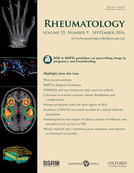
Authors: Sandro F. Perazzio Átila Granados Reinaldo Salomão Neusa P. Silva Magda Carneiro-Sampaio Luis Eduardo C. Andrade
Abstract
Objective: To determine the frequency of immunodeficiency-like states in SLE and related clinical features.
Methods: Three hundred and fifteen SLE patients and 301 controls were evaluated for C4A and C4B gene copy number, immunoglobulin isotypes, IgG subclasses, total haemolytic complement (CH50), C2, C3 and neutrophil oxidative burst. C2 and C3 genes were sequenced in cases of low C2 or C3 levels. Those presenting abnormal CH50 with normal C2 and C3 underwent C1q–C9 determination. Patients with active SLE and abnormal results were re-tested after the flare or were excluded if no remission was attained. Fifteen patients were excluded on this basis. Persistent abnormal results characterized an immunodeficiency-like state.
Results: A significantly higher percentage of SLE patients presented an immunodeficiency-like state compared with controls (28.7% vs 3.3%; P < 0.001), especially low immunoglobulin serum levels. Rigorous testing confirmed only two cases of C2 deficiency carriers among the SLE patients. There were significantly more SLE patients with less than two C4A copies compared with controls. SLE patients had higher frequency of low IgG 2 , IgG 3 , IgG 4 and IgM levels compared with controls. Patients with low IgG 3 or IgG 4 presented higher frequency of lupus nephropathy. Patients with low IgM had longer disease duration, older age at SLE onset and lower frequency of oral ulcers.
Conclusion: An immunodeficiency-like state is present in a sizable fraction of SLE patients. Further studies are warranted to determine the impact of these immunodeficiency states and whether they are a primary condition or are secondary to confounding factors, including SLE itself.
Keywords: systemic lupus erythematosus, primary immunodeficiency, autoimmune diseases, immunoglobulin deficiency
DOI: https://doi.org/10.1093/rheumatology/kew227


